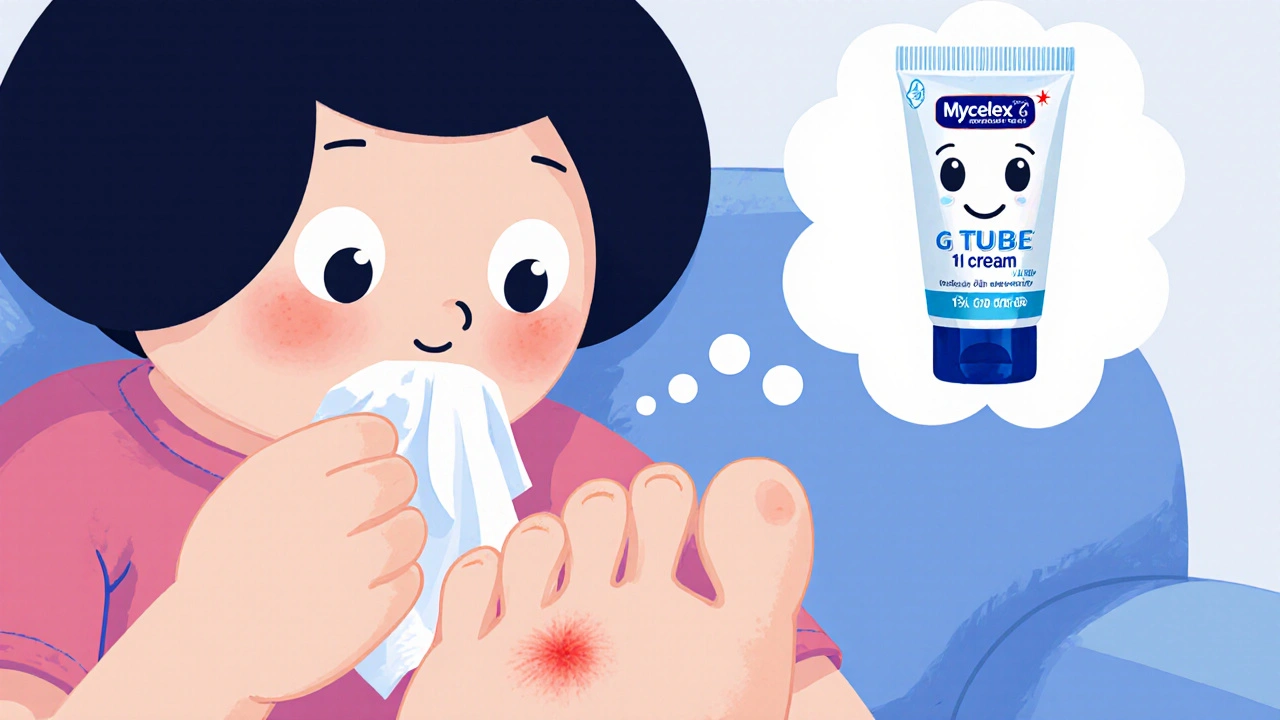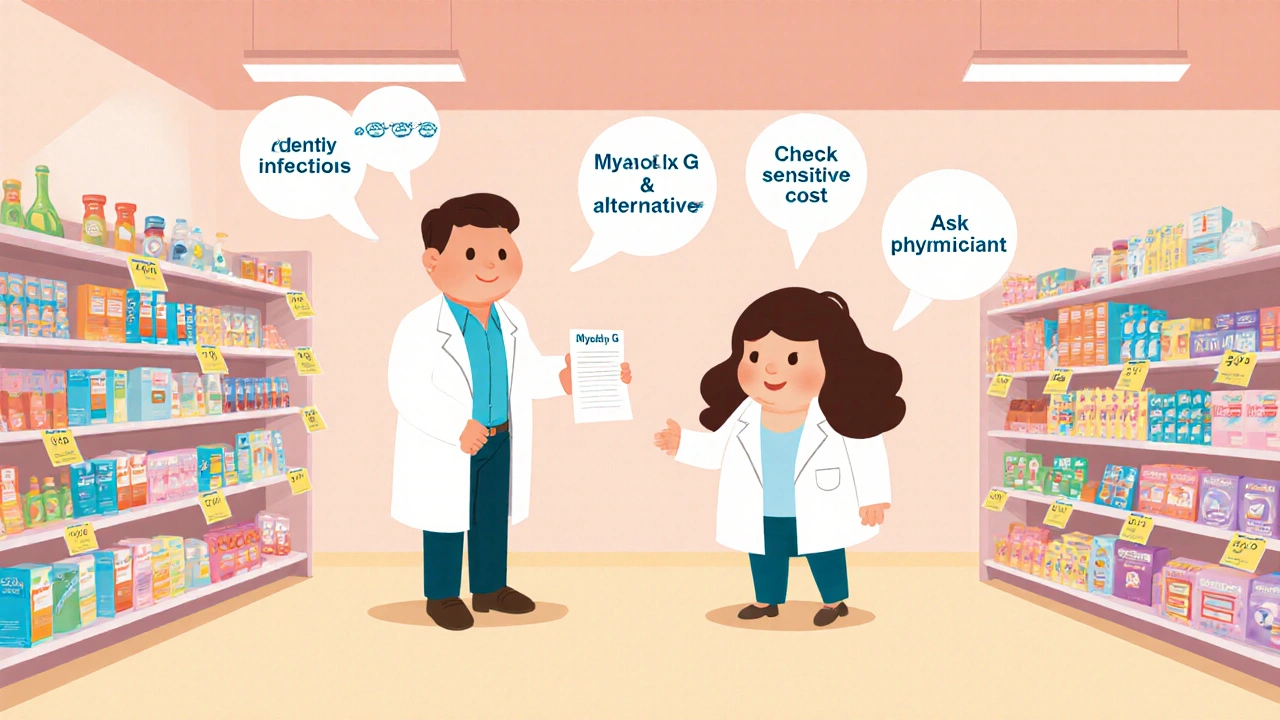Mycelex G (Clotrimazole) vs Top Antifungal Alternatives: Compare Effectiveness, Cost & Safety

When a rash, itch, or burning sensation tells you you’ve got a fungal infection, the first thought is usually: reach for an antifungal cream. But with dozens of products on the shelf, how do you know which one really works, costs less, and stays safe? This guide breaks down Mycelex G - the brand name for Clotrimazole - and puts it side‑by‑side with the most common over‑the‑counter (OTC) and prescription rivals.
Key Takeaways
- Mycelex G (Clotrimazole) is an OTC azole with a 70‑90% cure rate for most superficial dermatophyte infections.
- Terbinafine (Lamisil) often heals faster and boasts the highest cure rates, but it’s pricier and sometimes prescription‑only.
- Miconazole offers a broader spectrum against yeast infections, making it a better choice for candidiasis.
- Ketoconazole and ciclopirox are useful for resistant cases, but they can cause more skin irritation.
- Choosing the right product depends on infection type, skin sensitivity, cost, and whether you need a prescription.
What Is Mycelex G?
Mycelex G (Clotrimazole) is an azole‑based antifungal cream approved for treating athlete’s foot, jock itch, ringworm, and yeast infections of the skin. It’s sold in 1% strength tubes, 2% gels, and a 1% spray, all of which are available without a prescription in the United States. The brand has been on pharmacy shelves since the early 1990s and remains a go‑to option for people who want a quick, inexpensive fix.
How Clotrimazole Works
Clotrimazole belongs to the imidazole class. It targets the fungal cell membrane by inhibiting the enzyme lanosterol 14‑α‑demethylase. Without this enzyme, the fungus can’t synthesize ergosterol, a key component that keeps its cell wall stable. The result is a leaky membrane that leads to fungal death. Because the drug attacks a process that human cells don’t use, side effects are rare and usually limited to mild skin irritation.
Top Antifungal Alternatives
Below are the four most frequently compared rivals. All of them are either OTC or prescription products commonly stocked at drugstores, online pharmacies, and clinics.
Miconazole
Miconazole nitrate comes in 2% creams, sprays, and powders. It’s an azole like clotrimazole but has a slightly broader spectrum, especially against Candida species. Miconazole is also available OTC and is often recommended for diaper rash and oral thrush when used as a lozenge.
Terbinafine
Terbinafine (brand name Lamisil) is an allylamine that disrupts fungal cell wall synthesis in a different way than azoles. It’s available as a 1% cream OTC and as a 250 mg oral tablet prescription. Clinical trials show cure rates of 95% for tinea pedis, making it the most effective topical for athlete’s foot.
Ketoconazole
Ketoconazole was once a first‑line topical for many skin fungi, but concerns about systemic absorption led to stricter regulations. Today you’ll find it mostly in 2% creams for prescription use, targeting resistant dermatophytes and seborrheic dermatitis.
Ciclopirox
Ciclopirox (brand name Loprox) is a hydroxypyridone that chelates metal ions needed for fungal enzymes. It’s sold as a 1% nail lacquer for onychomycosis, and as a 0.77% cream for skin infections. While not as fast‑acting as terbinafine, it’s valuable for nail‑plate infections where other agents struggle.
Side‑by‑Side Comparison
| Attribute | Mycelex G (Clotrimazole) | Miconazole | Terbinafine | Ketoconazole | Ciclopirox |
|---|---|---|---|---|---|
| Active ingredient | Clotrimazole 1% or 2% | Miconazole nitrate 2% | Terbinafine 1% (topical) / 250 mg (oral) | Ketoconazole 2% | Ciclopirox 0.77% (cream) / 1% (lacquer) |
| OTC status (US) | OTC | OTC | Topical OTC, oral prescription | Prescription only | Prescription for nail lacquer, OTC cream |
| Typical uses | Athlete’s foot, jock itch, ringworm, yeast infections | Same + diaper rash, oral thrush (lozenge) | Athlete’s foot, jock itch, onychomycosis (oral) | Resistant dermatophytes, seborrheic dermatitis | Nail fungus, resistant skin infections |
| Cure rate (clinical avg.) | 70‑90% | 75‑92% | 90‑95% | 65‑80% | 55‑70% (nail), 70‑85% (skin) |
| Common side effects | Mild burning, itching | Burning, occasional redness | Transient itching, rare rash | Skin irritation, rare hepatitis (systemic) | Local irritation, discoloration of nail lacquer |
| Average price (US, 2025) | $5‑$8 for 30 g tube | $6‑$9 for 30 g tube | $8‑$12 for 30 g tube; $30‑$45 for 30‑day oral pack | $12‑$18 prescription | $20‑$28 for lacquer, $7‑$10 for cream |
Choosing the Right Treatment
There’s no one‑size‑fits‑all answer. Below is a quick decision tree you can follow while you’re standing in the pharmacy aisle.
- Identify the infection. Is it a classic athlete’s foot (tinea pedis), a yeast infection (candidiasis), or a nail fungus?
- Check skin sensitivity. If you’ve had irritation with azoles before, you might skip clotrimazole and try terbinafine.
- Consider cost and convenience. For a short‑term rash, an OTC tube under $10 is usually enough. For stubborn nail infections, the higher‑priced lacquer could be worth it.
- Ask your pharmacist or doctor. Prescription‑only agents like ketoconazole are reserved for resistant cases or when you need systemic coverage.
In practice, many people start with Mycelex G because it’s cheap, easy to apply, and works for the most common skin fungi. If symptoms persist after two weeks, switch to a stronger option like terbinafine or consult a clinician.

Common Questions & Myths
Below are a few misconceptions that pop up in forums and at the pharmacy counter.
- Mycelex G is only for athletes. False - it treats any superficial fungal skin infection, not just athlete’s foot.
- All antifungals are the same. Incorrect - each active ingredient targets the fungus differently, affecting speed of cure and side‑effect profile.
- Using more cream speeds up healing. Not true - applying a thin layer twice daily is sufficient; excess cream can increase irritation.
- Natural remedies are safer. While tea tree oil and garlic have antifungal properties, they lack the consistent clinical data that azoles and allylamines provide.
Bottom Line
If you need a reliable, low‑cost solution for a typical skin fungus, Mycelex G (Clotrimazole) is a solid first choice. For faster results on athlete’s foot, terbinafine edges it out. When you’re dealing with yeast‑dominant infections or resistant strains, consider miconazole, ketoconazole, or ciclopirox. Always read the label, watch for irritation, and don’t hesitate to ask a healthcare professional if the rash doesn’t improve within the recommended time frame.
Frequently Asked Questions
Can I use Mycelex G on my face?
Yes, but only for short‑term fungal infections like facial tinea. Apply a thin layer and stop if you notice redness or swelling.
How long does it take for Mycelex G to work?
Most users see improvement within 3‑5 days, but the full course is usually two weeks to prevent recurrence.
Is Mycelex G safe for children?
The 1% cream is approved for children over 2 years old. For infants, a pediatrician‑recommended antifungal like miconazole powder is often preferred.
Can I combine Mycelex G with other skin products?
Apply Mycelex G first, let it absorb for a few minutes, then you can use moisturizers or barrier creams. Avoid layering another antifungal on top without a doctor’s advice.
When should I see a doctor instead of self‑treating?
If the rash spreads, causes severe pain, shows pus, or doesn’t improve after 14 days of proper use, schedule a medical visit. Persistent nail discoloration also warrants professional evaluation.

9 Comments
Clotrimazole is literally the gold standard-why are people even debating this? If you're using anything else without a prescription, you're just throwing money away. And please, stop using natural remedies-tea tree oil is not a substitute for clinically proven antifungals. I've seen people ruin their skin with essential oils. Just use the cream. It's $6. Done.
My dad used clotrimazole for his jock itch back in '98 and it worked like magic. I tried terbinafine last year for athlete’s foot-faster, yeah, but also way pricier. For most cases, Mycelex G is totally fine. Just apply it twice a day and don’t stop early. I’ve seen people quit after 5 days and wonder why it came back.
Just want to say-this guide is actually really clear. No fluff. Straight facts. I’ve been dealing with a stubborn ringworm for months and this helped me pick the right cream. Thanks for the breakdown.
Okay but let’s be real-nobody reads the whole table. I just skimmed the price and cure rate columns and went with clotrimazole because it was cheap and I didn’t have a prescription. And guess what? It worked. I mean, I didn’t need terbinafine for a simple case of athlete’s foot between my toes. I’m not a scientist, I’m a person who just wants the itch to stop. Also, I used the spray version because I’m lazy and don’t want to rub cream in. It’s fine. Don’t overthink it. If your rash is still there after two weeks, yeah, go see someone. But for 90% of us? Mycelex G is the MVP. Also, please stop saying ‘natural remedies are safer.’ I’ve seen people put apple cider vinegar on open sores. That’s not safer. That’s just tragic.
Table is formatted wrong. Missing closing tag on the header row. Also, 'cure rate' isn't a clinical term-it's 'mycological cure rate' or 'clinical cure rate.' And why is ketoconazole listed as 65-80%? That’s outdated. Recent meta-analyses show 72-85%. This guide is sloppy.
Clotrimazole? Cute. I used ciclopirox lacquer for my toenail fungus last year-$25 for a bottle that lasted 6 months. You think you're saving money with Mycelex G? You're just delaying the inevitable. Real men don't use OTC creams. We treat the root cause. Also, terbinafine oral is the only real solution. Everything else is just placebo with a brand name.
Let me break this down for you, because clearly you’re all too lazy to read the actual pharmacokinetics: Clotrimazole inhibits lanosterol 14-alpha-demethylase-CYP51A1, to be precise-leading to ergosterol depletion and membrane disruption. Terbinafine inhibits squalene epoxidase, causing squalene accumulation and fungal autolysis. The cure rate difference isn’t just ‘a bit better’-it’s statistically significant (p<0.01) in RCTs. And ketoconazole? Don’t even get me started. Topical ketoconazole has a 2.3x higher risk of hepatotoxicity than azoles in patients over 50. This isn’t a ‘choose what’s cheap’ situation. This is biochemistry. You’re not ‘saving money’-you’re gambling with your liver. And yes, I’m a pharmacist. And no, I don’t care if you ‘just want it to stop.’
Why are we even letting this crap be sold OTC? Clotrimazole is basically a glorified Band-Aid for a bullet wound. And people in the U.S. are fine with this? Meanwhile, in Germany, you need a prescription for anything weaker than terbinafine. We’re letting people treat life-threatening fungal infections with $6 cream because we’re too lazy to go to a doctor. This isn’t healthcare-it’s a carnival game. And don’t even get me started on ‘natural remedies.’ If you’re putting garlic on your groin, you deserve what you get.
Hey everyone-just want to say this guide is super helpful. I’ve been dealing with a yeast rash for months and kept switching creams. This finally helped me pick the right one. Also, if you’re worried about cost, most pharmacies have coupons. Mycelex G is like $3 with a coupon. And if you’re unsure? Ask the pharmacist. They’re usually happy to help. No need to feel dumb. We’ve all been there.